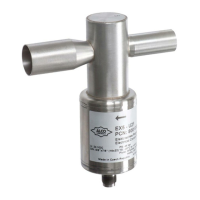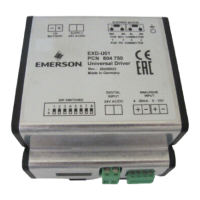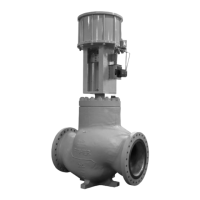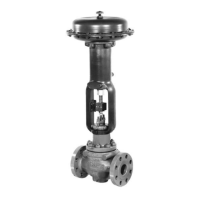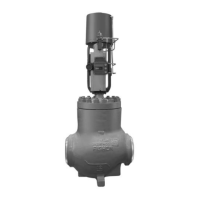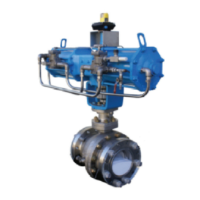Safety
Information
Introduction Installation
PowerTools
Pro Software
Communications
How
Motion
Works
How I/O
Works
Configuring
an
Application
Programming
Starting and
Stopping
Motion
Starting and
Stopping
Programs
Parameter
Descriptions
Drive
Parameters
Used by
EZMotion
Diagnostics Glossary Index
EZMotion User/Programming Guide 145
Revision A8 www.controltechniques.com
7 How I/O Works
7.1 I/O Scan
When used to activate EZMotion functions, the Unidrive SP/Digitax ST and EZMotion I/O are scanned every trajectory update.
If the Unidrive SP/Digitax ST I/O is used to trigger functions in the base drive itself (i.e. Threshold Detectors, Programmable
Logic, Binary Sum, etc.), then the Unidrive SP/Digitax ST I/O is only scanned every 4 milliseconds. The scan rate is different
when the Unidrive SP/Digitax ST I/O is used with EZMotion functions because the EZMotion processor scans the I/O faster
than the base drive firmware does.
7.2 EZMotion I/O
There are four digital inputs and two digital outputs on the EZMotion connector. These I/O are scanned normally at the
trajectory update rate (user configured). If an input is assigned to a function that does not use captured data, then it will be
updated every trajectory update.
The EZMotion I/O can also be captured with 1 microsecond accuracy by using the High Speed Capture object in the SM-
EZMotion module. If an input is assigned to a function that uses captured data (i.e. Index.#.Initiate), then the input will
automatically be captured with 1 microsecond accuracy, and the data is passed to the destination.
To use the EZMotion I/O in the PowerTools Pro Assignments view, the four Inputs are called EZInput.# and the two Outputs
are called EZOutput.# (where # represents the specific I/O number)
7.3 Unidrive SP/Digitax ST I/O
The Unidrive SP/Digitax ST has three I/O points that are configured by the user to be Inputs or Outputs, along with three
dedicated Inputs. The scan rate of the I/O on the Unidrive SP/Digitax ST depends on what they are being used for. If the I/O
are being used by EZMotion functions, then they are updated every trajectory update (user configured). If the I/O are being
used solely for Unidrive SP/Digitax ST functions (i.e. Threshold Detectors, Programmable Logic, Binary Sum, etc.), then they
are updated every 4 milliseconds.
To use theUnidrive SP/Digitax ST I/O in the PowerTools Pro Assignments view, the three Input/Output lines are called
SPIO.#.In or SPIO.#.Out depending on how they are configured (where # represents the specific I/O number). The configured
Input/Output lines will be listed both on the Inputs group of Sources, and the Outputs group of Destinations. Therefore, it is
important for the user to know how the Inputs/Outputs have been configured. The dedicated Inputs are referred to as
SPInput.# (where # represents the specific I/O number).
7.4 SM-I/O Plus Module I/O
The SM-I/O Plus module has three I/O points that are configured by the user to be Inputs or Outputs, along with three
dedicated Inputs. The scan rate of the I/O on the SM-I/O Plus module depends on how many SM-I/O Plus modules are being
used. If using one SM-I/O Plus module, the I/O on the SM-I/O Plus module is updated every 8 milliseconds. If a second SM-I/
O Plus module is used, the I/O on both SM-I/O Plus modules are updated every 16 milliseconds.
To use the Unidrive SP/Digitax ST I/O in the PowerTools Pro Assignments view, the three Input/Output lines are called
SlotX.IO.#.In or SlotX.IO.#.Out depending on how they are configured (where X represents the slot number the module is
located in, and # represents the specific I/O number). The configured Input/Output lines will be listed both under the Inputs
group of Sources, and the Outputs group of Destinations. Therefore, it is important for the user to know how the Inputs/
Outputs have been configured. The dedicated Inputs are referred to as SlotX.Input.# (where X represents the slot number the
module is located in, and # represents the specific I/O number).
Because of the slower scan rate of the SM-I/O Plus module inputs and outputs, it is recommended that these I/O not be used
for critical motion functions (e.g. Home Switches, Registration Sensors, Travel Limits, PLS’s, etc.).
7.5 SM-I/O 32 Module I/O
The SM-32 I/O module has 32 I/O points that are configured by the user to be Inputs or Outputs. The outputs are updated at
the same rate as the control loop.
Menu’s 20.38-40 are used by the EZMotion to support the device. If a second device is used, menu’s 20.35-37 are used to
support that module.

